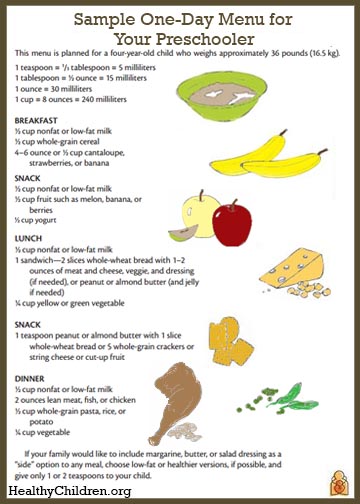During the preschool years, your child should be eating the same foods as the rest of the family, with an emphasis on those with nutritional value. This includes fresh vegetables and fruits, nonfat or low-fat dairy products (milk, yogurt, cheeses), lean meats (chicken, turkey, fish, lean hamburger), and whole grain cereals and bread. At the same time, limit or eliminate the junk food in your child's diet, and get rid of sugared beverages as well.
See the following sample menu ideas for a four-year-old child.
Note: This menu is planned for a four-year-old child who weighs approximately 36 pounds (16.5 kg).
1 teaspoon = 1⁄3 tablespoon (5 mL)
1 tablespoon = ½ ounce (15 mL)
1 ounce = 30 mL
1 cup = 8 ounces (240 mL)
Breakfast
- ½ cup nonfat or low-fat milk
- ½ cup cereal
- 4–6 oz. or ½ cup cantaloupe or strawberries or banana
Snack
- ½ cup nonfat or low-fat milk
- ½ cup fruit such as melon, banana, or berries
- ½ cup yogurt
Lunch
- ½ cup nonfat or low-fat milk
- 1 sandwich—2 slices whole wheat bread with 1–2 oz. of meat and cheese, veggie and dressing (if needed) or peanut butter and jelly
- ¼ cup dark-yellow or dark-green vegetable
Snack
- 1 teaspoon peanut butter with 1 slice whole wheat bread or 5 crackers or string cheese or cut-up fruit
Dinner
- ½ cup nonfat or low-fat milk
- 2 ounces meat, fish, or chicken
- ½ cup pasta, rice, or potato
- ¼ cup vegetable
If your family would like to include margarine, butter, or salad dressing as a "side" option to any meal, choose low- fat or healthier versions, if possible, and only give 1 or 2 teaspoons to your child.
Additional Information on HealthyChildren.org: